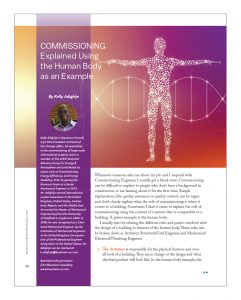Commissioning Explained Using the Human Body as an Example
Whenever someone asks me about my job and I respond with Commissioning Engineer, I usually get a blank stare. Commissioning can be difficult to explain to people who don’t have a background in construction or are hearing about it for the first time. Simple
explanations, like quality assurance or quality control, can be vague and don’t clearly explain what the role of commissioning is when it comes to a building. Sometimes I find it easier to explain the role of commissioning using the context of a system that is comparable to a building. A prime example is the human body.
I usually start by relating the different roles and parties involved with the design of a building to features of the human body. These roles can be broken down as Architect, Structural/Civil Engineer, and Mechanical/Electrical/Plumbing Engineer.
- The Architect is responsible for the physical features and overall look of a building. They are in charge of the design and what the final product will look like. In the human body example, the architect would determine the physical features. Whether it’s short or tall, large or small, what the color of the skin, hair, and eyes are, etc.
- The Structural/Civil Engineer is responsible for the structural support system that holds the building up. This is the steel and concrete framing that make up the walls, floors, and ceilings of the building. The support system in the human body is the skeleton with all its joints. The bones need to be strong and resilient enough to support the rest of the body.
- The Mechanical/Electrical/Plumbing Engineer is responsible for the function of the building. They design the systems that provide and regulate heating, cooling, water, lighting, and power. In the human body, these systems can be compared to the organs, respiratory, digestive, and nervous systems. They control, operate, and maintain the human body over its life span.
So where does the Commissioning Engineer fit into all this?
The Commissioning Engineer is like a doctor. They ensure that the body is operating properly by looking at the different systems of the body by running tests and diagnostics and making sure that they are interacting correctly with each other and supporting the function of the body as intended. Commissioning is taking a holistic look at the different systems of a building and verifying that they support and fulfill the intent of the building design. This is relevant in all stages of a building lifespan, from initial design, to development and construction, to operation of the building.
Just like the human body, a building ages and needs to undergo regular check-ups to find out ways to improve and prolong performance. So, call your local commissioning engineer today to ensure that your building’s intent, design, and operation gets a clean bill of health!
Copyright Statement
This article was published in the August 2018 issue of Insulation Outlook magazine. Copyright © 2018 National Insulation Association. All rights reserved. The contents of this website and Insulation Outlook magazine may not be reproduced in any means, in whole or in part, without the prior written permission of the publisher and NIA. Any unauthorized duplication is strictly prohibited and would violate NIA’s copyright and may violate other copyright agreements that NIA has with authors and partners. Contact publisher@insulation.org to reprint or reproduce this content.
Reprinted with permission from Baumann Consulting www.baumann-us.com.

